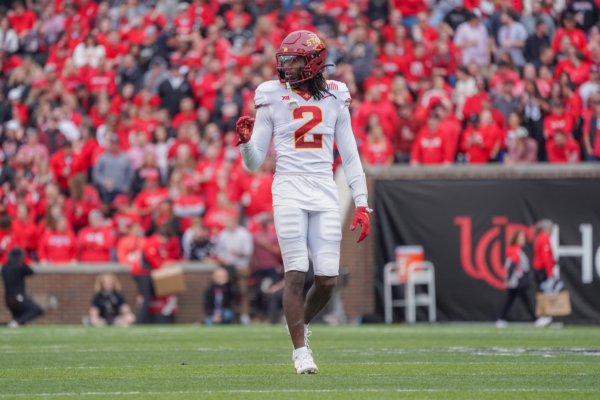The meaning behind the monument
April 8, 2008
Editor’s note: This is the first in a two part series looking back at a plane crash that killed two ISU student athletes in addition to another ISU student. Part two will appear in Wednesday’s Sports section.
There it lies, hiding in plain sight.
It could not be more visible to the naked eye. Its dirty white color easily protrudes from the field of grass that encompasses it.
Each and every day, hundreds of students walk briskly by the oversized rock that sits 90 feet due north of the Farm House Museum. Yet no one seems to notice or even care that it exists.
If just one person took a few extra seconds out of their day, they would see the simple beauty of this stone.
Embedded in its surface is a small, yet very effective plaque. It measures 8 inches by 10 inches and contains just six words – the names of three people. It reads, from top to bottom, Jeff Myers, Laura Vernon and Brian Vincent.
Located near the top right corner of the stone is an imprint of a seashell. Its presence on the stone is fitting, since the three names listed made a lasting impression on everyone they knew.
The overall message it displays is subtle, providing no clues to who these three individuals were.
Myers, Vernon and Vincent were all student-athletes at Iowa State during the late ’70s. But to the people closest to them, they were much more. They were role models and, at the same time, they were friends. However, on February 25, 1978, a Saturday, the lives of those who knew them best would be changed forever – on a flight to Colorado for spring break, their plane encountered an unknown problem and crashed into a field. Tragically, all aboard the plane were killed upon impact.
To Steve Gering, a member of the ISU track team with Myers and Vincent, the details of that heart wrenching date are still engraved in his memory just more than 30 years later.
“To this day, I can vividly remember how the field house looked, what the weather was like, even where I was when I first heard the terrible news. It was really hard for me – losing them – since I had such an amazing bond with both. We were so close; it seemed like we were brothers.”
That Saturday afternoon the team was scheduled to compete in the Big 8 Indoor Track Championships in Lincoln, Neb. Coach Bill Bergan, fully aware that Myers was under the weather with a cold, offered to replace him in the mile and 1,000-meter race with another runner.
While others would have easily accepted this proposal, Myers politely declined. As Gering points out, his decision to compete without his “A” game was one of the factors that made him such a great leader.
“He was a great person to look up to because he was always willing to give 110 percent every time he went out there. He would never give up, never say quit,” Gering said. “No matter what, you knew that he was always willing to try his hardest.”
Despite giving his best effort, Myers’ performance was clearly affected by his sub-par health. At full strength he was easily one of the best long distance runners in the country. On this day, however, he was unable to even finish in the top six in either of his races.
Rather than dwelling on his disappointing performance, Myers’ focus quickly turned to his plans for spring break. The trip to Colorado was one that Myers had long been awaiting. As the day drew nearer, he exhibited an unbridled enthusiasm that was difficult for his friends to overlook.
“On Friday, I talked with Jeff on the bus ride to Lincoln. You could just tell by his voice that he was very excited to go skiing. I remember him saying that he was looking forward to being able to take a break and just get away for a while,” Gering said.
Immediately following their track meet in Lincoln, Myers and Vincent boarded a plane that was headed to Colorado for a week of skiing. The two were accompanied on the flight by Myers’s girlfriend, Laura Vernon, and her younger brother, Andrew. The aircraft was a single engine Cessna 206 piloted by Laura’s father, Dr. Robert Vernon.
At 5:20 p.m., the plane departed from the Lincoln airport, heading to Denver. The initial plan, upon leaving Lincoln, was to enter Denver from the north. Vernon modified the idea, however, after he talked to air traffic controller Harold Ward in Grand Island, Neb. Ward informed Vernon that the northern part of Colorado was faced with inclement weather conditions that made flying unsafe. For their own safety, he recommended that they take the southern route to Denver, via Colorado Springs.
The last known contact Vernon ever had was at 7:05 p.m., when he provided the La Junta, Colo., airport with his current position.
Little did he know, but he was only 27 miles east of his eternal resting place.
The search for the plane began only after Mimi Vernon, wife of Dr. Vernon and mother of Laura, started to fear the worst. After failing to receive the customary phone call that signaled his safe arrival, Mimi informed the Flight Services Administration office in Cedar Rapids that the airplane piloted by her husband Robert was missing.
Shortly after Mimi’s report, a spokesman for the family contacted Bergan with the disheartening news. To this day that horrific phone call brings tears to enter his eyes.
“When I received the phone call, saying their plane went missing, I knew it was my responsibility – as a coach – to inform the Myers and Vincent families. I will never forget that day,” Bergan said. “Even now, I can tell you exactly where I was standing and where I was using the phone. It is just one of those events that remains with you over the course of time.”
Just like his coach, Gene McGivern will never be able to forget his initial reaction to that life altering news.
“It seemed like it was a bad dream that you would never to be able to wake up from,” McGivern said. “One day they’re right here making jokes and laughing with you. Then the next, they’re gone. It still seems so surreal to me.”
Dennis Barker tried to remain positive when he first heard that the plane was missing. He regrets saying it but, he knew he prepared himself for the worst.
“A small plane like that missing is never a good thing. I wanted to hold out hope, but at the same time I knew that I needed to be realistic,” Barker said. “I knew that there was a good chance I would never see my friends again.”
Tragically, Barker’s worst fear was confirmed at 11:30 p.m. on Sunday, the 26th. After a commercial airliner reported picking up a distress signal in the area, the Colorado Civil Air Patrol found what they confirmed to be the remnants of the missing Vernon plane.
The Cessna 206 was discovered in a field three miles northeast of Yoder, Colo. Something inexplicably went wrong for the crash to happen in the manner it did. For some unknown reason, the plane plummeted from the sky with its throttle fully open. Traveling at a speed no less than 150 mph, the aircraft slammed nose first into the ground, killing all five passengers on board. Furthermore, investigators found that the sheer force of the impact caused the plane to skid for 150 yards before snapping in half. The separated tail portion of the plane then proceeded to flip completely over before it finally came to rest atop the passengers’ compartment.

















Liz Noyes | May 12, 2023 at 11:08 pm
The students that were killed were all incredible! As were Dr. Vernon and Andrew. I was a friend of Laura’s and she was one of the most powerful influences on my life at the time, and for years after.